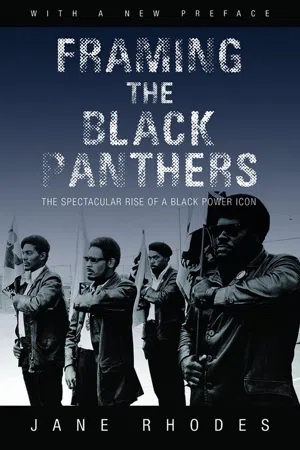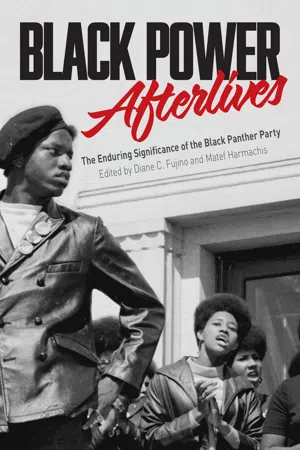Black Panther Party
The Black Panther Party was a revolutionary socialist organization founded in 1966 in the United States. It aimed to challenge police brutality and systemic racism, advocating for the empowerment and self-defense of African American communities. The party also provided social programs such as free breakfast for children and healthcare clinics, leaving a lasting impact on the civil rights movement.
6 Key excerpts on "Black Panther Party"
- eBook - ePub
Protest Nation
Words That Inspired a Century of American Radicalism
- Timothy Patrick McCarthy, John McMillian, Timothy Patrick McCarthy, John McMillian(Authors)
- 2010(Publication Date)
- The New Press(Publisher)
...16. THE Black Panther Party What We Want, What We Believe (1966) The “Black Panther Party Platform” outlined what cofounder Huey P. Newton called “the essential points for the survival of Black and oppressed people in the United States.” THE Black Panther Party FOR SELF-DEFENSE was formed in October 1966 in Oakland, California, by Newton and Bobby Seale, and it soon became the most storied black militant organization of the late 1960s. The Panthers called for African Americans to arm themselves in self-defense, and in their early days they followed police cars that patrolled black neighborhoods to see that the police didn’t violate anyone’s civil rights. Accordingly, they were the target of severe harassment and infiltration from law enforcement agencies, and they were involved in several violent confrontations with police. During the early 1970s the group’s influence waned under the pressures of government repression, legal difficulties, and internal schisms. SOURCE: Reprinted in Deirdre Mullane, Crossing the Danger Water: Three Hundred Years of African-American Writing. New York: Doubleday, 1993. SELECTED READINGS: Charles E. Jones, ed., The Black Panther Party (Reconsidered) (1998). Hugh Pearson, The Shadow of the Panther: Huey Newton and the Price of Black Power in America (1994). Huey P. Newton, Revolutionary Suicide (1973). 1. We want freedom. We want power to determine the destiny of our Black Community. We believe that black people will not be free until we are able to determine our destiny. 2. We want full employment for our people. We believe that the federal government is responsible and obligated to give every man employment or a guaranteed income...
- eBook - ePub
Up Against the Wall
Violence in the Making and Unmaking of the Black Panther Party
- Curtis J. Austin(Author)
- 2008(Publication Date)
- University of Arkansas Press(Publisher)
...CHAPTER 2 The Black Panther Party for Self-Defense AFTER ABOUT A MONTH OF GOING IN AND out of their office on Fifty-sixth and Grove in Oakland openly displaying their weapons, the moment of truth finally arrived. 1 Bobby Seale wrote that by early 1967 “Huey was on a level where he was ready to organize the black brothers for a righteous revolutionary struggle with guns and force.” In addition to its founders, the Black Panther Party’s members at this time included Sherman and Reginald Forte, Bobby Hutton, and Elbert Howard. Hoping for the opportunity to demonstrate to the community that their philosophy and tactics helped advance the cause of black liberation, they held political education classes daily in an attempt to bring ideological uniformity to the group. They also had sessions where they learned how to break down, clean, and reassemble weapons, to fire them, and to handle them safely. Newton wrote, “a number of people who [he] knew had just come from Vietnam, and they helped train [the Panthers] in weaponry.” Oakland resident John Sloane, who had been in the military, gave the group its first lessons on “field stripping and shooting,” according to Seale. (The following chapters further address the Vietnam connection in the following chapters.) One frigid day in early February 1967, several well-armed Panthers were leaving the office when an Oakland police officer cruised by. The officer continued down the street, radioed to headquarters then quickly made a U-turn and drove back toward the Panthers, who were by then getting into their car to leave. Just as they expected, the police officer pulled behind them...
- Jacopo Galimberti, Noemi de Haro García, Victoria H. F. Scott(Authors)
- 2019(Publication Date)
- Manchester University Press(Publisher)
...Without a Doubt’. Back page poster in the Black Panther newspaper, 21 August 1971 A Black Maoism? The Black Panther Party for Self Defense began in Oakland, California, in 1966, just five months after the beginning of the Great Proletarian Cultural Revolution in China. According to Kathleen Cleaver, the BPP's Communications Secretary and its first female leader, ‘few activists and revolutionaries in the US had a really clear appreciation of Chinese history – they read things that Mao wrote and they read things written about Mao’. She explained that the few Chinese posters they saw had a huge visual influence because they were ‘part of the “vibe” … They symbolised the height of revolution.’ 4 At the same time as the Cultural Revolution, the BPP's leaders and ministers presented political and economic alternatives to capitalism and the perceived racist imperialism that grew out of it. The young black men and women who formed the party looked to the writings of international leaders like Frantz Fanon, Malcolm X and Mao. Despite the fact that China eventually made ‘disastrous foreign policy decisions vis-à-vis Africa and the Third World’, at the time the Black Panther Party was operating ‘China was the most powerful “coloured” nation on earth’. 5 In mid-1967 the American artist Emory Douglas became the BPP's Minister of Culture, responsible for the visual parts of its influential weekly publication, then called The Black Panther Community News Service and published in Oakland. The Black Panthers were organised under ministries – of defence, information, education and culture. Emory Douglas and the creative team who worked with him produced art in all its forms. 6 Working against systemic racism and discrimination in government and institutions, the BPP created a platform, programmes, principles and delivery systems for social services...
- eBook - ePub
Say It Loud!
Great Speeches on Civil Rights and African American Identity
- Catherine Ellis, Stephen Drury Smith, Catherine Ellis, Stephen Drury Smith(Authors)
- 2010(Publication Date)
- The New Press(Publisher)
...8. B OBBY S EALE (1936–) Speech delivered at the Kaleidoscope Theater Los Angeles, California—April 16, 1968 Bobby Seale was chairman of the Black Panther Party during the most violent, tumultuous period of the Black Power movement. Beginning in late 1966, Seale helped expand the reach and influence of the Panthers from their home base of Oakland, California, to more than thirty cities nationwide. The Panthers engaged in militant rallies, hair-raising confrontations with police, and community service programs aimed at helping the poor. They preached armed self-defense against police brutality and revolution against white power structures, quickly topping the FBI’s list of national threats. 1 For a time, Bobby Seale and the Black Panthers represented “the face of the new radicalism,” historian Peniel Joseph writes. “Comprised of reformed troublemakers, college students and ex-cons, the Panthers brandished guns and law books in an effort—sometimes quixotic—to foment revolution from below.” 2 Bobby Seale was born in Dallas, Texas, in 1936. He says he “grew up just like any other [black] brother,” in a family that never had much money. 3 The family eventually moved to Berkeley, California, and lived in a housing project that Seale remembers as crowded and dirty. As a teenager, Seale joined the air force but was discharged for bad conduct. The turning point in Seale’s life came in 1962, when he met Huey Newton, a fellow student at Merritt College in Oakland. Seale was deeply impressed with Newton’s intellect, his revolutionary views on politics, and his willingness to use violence to change society. According to Seale, many left-wing activists he knew shied away from using weapons, but Newton said, “You must pick up guns, because guns are key.” 4 Bobby Seale and Huey Newton formed the Black Panther Party on October 15, 1966...
- eBook - ePub
Framing the Black Panthers
The Spectacular Rise of a Black Power Icon
- Jane Rhodes(Author)
- 2017(Publication Date)
- University of Illinois Press(Publisher)
...“Millions and millions of oppressed people might not know members of the vanguard party personally or directly, but they will gain through an indirect acquaintance the proper strategy for liberation via the mass media and the physical activities of the party,” Newton proclaimed. In a few short years, the Black Panther Party created a global imagined community of radical activists that proved to be astonishingly effective despite governments’ efforts to silence them. But this far-flung community was not tied together by an official nationalism, with its allegiance to a nation-state. Rather, the Panthers helped to forge a global community of the aggrieved that crossed class and racial barriers. These disparate groupings, united in their struggles against imperialism, capitalism, and racism, aspired to a new “national” formation, one that embraced the underclass and the disenfranchised. 65 Neither stardom nor a powerful public relations apparatus nor an international presence could protect the Black Panthers from a stepped-up campaign by the government to shut them down. In June, FBI chief J. Edgar Hoover pledged that his agency would do everything in its power to bring about this outcome. In his often repeated proclamation, he declared, “The Black Panther Party, without question, represents the greatest threat to internal security of the country.” The statement, part of the FBI's 1969 annual report, argued that not only were the Black Panthers wreaking havoc in urban communities, but they “travel extensively all over the United States preaching their gospel of hate and violence…to students in colleges, universities and high schools as well.” It was published widely in the press. At the same time, a Senate subcommittee under the leadership of Senator John L. McClellan was conducting public hearings into the Black Panther Party...
- eBook - ePub
Black Power Afterlives
The Enduring Significance of the Black Panther Party
- Diane Fujino, Matef Harmachis, Diane Fujino, Matef Harmachis(Authors)
- 2020(Publication Date)
- Haymarket Books(Publisher)
...INTRODUCTION The Enduring Significance of the Black Panther Party Diane C. Fujino and Matef Harmachis There is a paradox in writing about the Black Panther Party for Self-Defense fifty years after its founding. The instant recognition of the Black Panther Party (BPP) contrasts with the sparsity of any sustained study of the Party’s continuing influence on later generations of activism. As is broadly acknowledged, the BPP is one of the most significant organizations of the twentieth century. There is now a sizeable literature of rigorous studies of the BPP, but nearly all of these, by design, examine the party during its existence. Yet even a cursory review of some of today’s most visible activist and cultural productions are revealing of the Black Panthers’ ongoing impact. The widely covered Black Lives Matter protests against police violence call to mind, in different form, the BPP’s famed police patrols. Mega-celebrity Beyoncé’s 2016 Super Bowl halftime performance was a clear reference to and celebration of the BPP. Football star Colin Kaepernick’s widely covered—and controversial—“taking a knee” against police brutality during the national anthem at NFL games harkens back to John Carlos and Tommie Smith raising the Black Power fist at the 1968 Olympic Games in Mexico City, with all three athletes inspired by the BPP. The 2018 smash hit movie Black Panther, a filmic version of the Marvel comic strips, invokes images and themes raised by the BPP. More quietly, an entire social service infrastructure has been developed since the 1960s, inspired in part by the BPP’s community survival programs...





